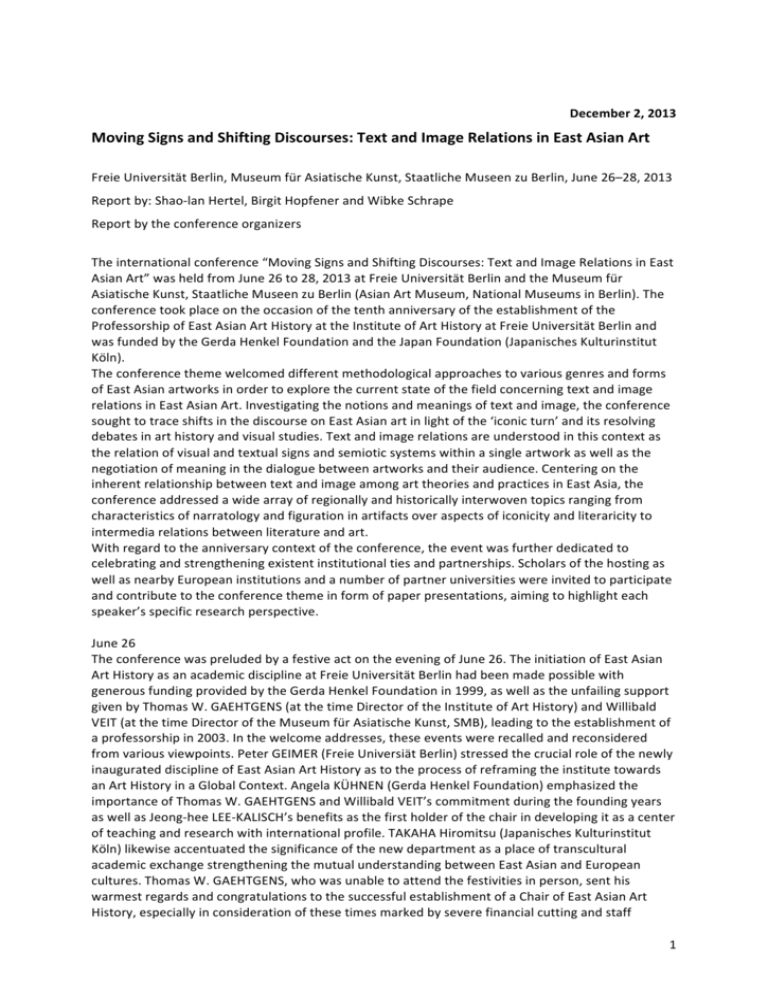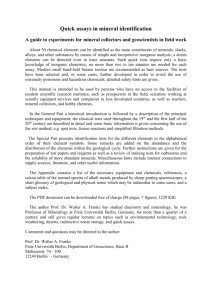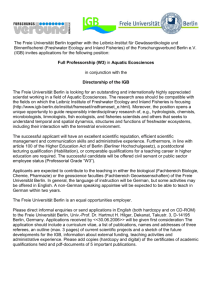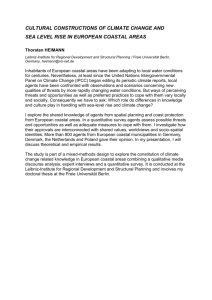Moving Signs and Shifting Discourses: Text and Image Relations in
advertisement

December 2, 2013 Moving Signs and Shifting Discourses: Text and Image Relations in East Asian Art Freie Universität Berlin, Museum für Asiatische Kunst, Staatliche Museen zu Berlin, June 26–28, 2013 Report by: Shao-­‐lan Hertel, Birgit Hopfener and Wibke Schrape Report by the conference organizers The international conference “Moving Signs and Shifting Discourses: Text and Image Relations in East Asian Art” was held from June 26 to 28, 2013 at Freie Universität Berlin and the Museum für Asiatische Kunst, Staatliche Museen zu Berlin (Asian Art Museum, National Museums in Berlin). The conference took place on the occasion of the tenth anniversary of the establishment of the Professorship of East Asian Art History at the Institute of Art History at Freie Universität Berlin and was funded by the Gerda Henkel Foundation and the Japan Foundation (Japanisches Kulturinstitut Köln). The conference theme welcomed different methodological approaches to various genres and forms of East Asian artworks in order to explore the current state of the field concerning text and image relations in East Asian Art. Investigating the notions and meanings of text and image, the conference sought to trace shifts in the discourse on East Asian art in light of the ‘iconic turn’ and its resolving debates in art history and visual studies. Text and image relations are understood in this context as the relation of visual and textual signs and semiotic systems within a single artwork as well as the negotiation of meaning in the dialogue between artworks and their audience. Centering on the inherent relationship between text and image among art theories and practices in East Asia, the conference addressed a wide array of regionally and historically interwoven topics ranging from characteristics of narratology and figuration in artifacts over aspects of iconicity and literaricity to intermedia relations between literature and art. With regard to the anniversary context of the conference, the event was further dedicated to celebrating and strengthening existent institutional ties and partnerships. Scholars of the hosting as well as nearby European institutions and a number of partner universities were invited to participate and contribute to the conference theme in form of paper presentations, aiming to highlight each speaker’s specific research perspective. June 26 The conference was preluded by a festive act on the evening of June 26. The initiation of East Asian Art History as an academic discipline at Freie Universität Berlin had been made possible with generous funding provided by the Gerda Henkel Foundation in 1999, as well as the unfailing support given by Thomas W. GAEHTGENS (at the time Director of the Institute of Art History) and Willibald VEIT (at the time Director of the Museum für Asiatische Kunst, SMB), leading to the establishment of a professorship in 2003. In the welcome addresses, these events were recalled and reconsidered from various viewpoints. Peter GEIMER (Freie Universiät Berlin) stressed the crucial role of the newly inaugurated discipline of East Asian Art History as to the process of reframing the institute towards an Art History in a Global Context. Angela KÜHNEN (Gerda Henkel Foundation) emphasized the importance of Thomas W. GAEHTGENS and Willibald VEIT’s commitment during the founding years as well as Jeong-­‐hee LEE-­‐KALISCH’s benefits as the first holder of the chair in developing it as a center of teaching and research with international profile. TAKAHA Hiromitsu (Japanisches Kulturinstitut Köln) likewise accentuated the significance of the new department as a place of transcultural academic exchange strengthening the mutual understanding between East Asian and European cultures. Thomas W. GAEHTGENS, who was unable to attend the festivities in person, sent his warmest regards and congratulations to the successful establishment of a Chair of East Asian Art History, especially in consideration of these times marked by severe financial cutting and staff 1 reduction. As the holder of the chair in question, Jeong-­‐hee LEE-­‐KALISCH brought to remembrance the notably long tradition of teaching East Asian Art History in Berlin in connection with the Ostasiatische Kunstsammlung, Museum für Asiatische Kunst, as well as among German speaking academia, thus commemorating her former teachers and colleagues Helmut BRINKER, Roger GOEPPER, Irmtraud SCHAARSCHMIDT-­‐RICHTER and Dietrich SECKEL. She further underlined the vital role that Willibald VEIT and her colleague Antje PAPIST-­‐MATSUO (Museum für Asiatische Kunst, SMB) played during the first years of teaching and facility building. These acknowledgments were completed by a note of thanks expressed by current students to Willibald VEIT, Antje PAPIST-­‐ MATSUO and Jeong-­‐hee LEE-­‐KALISCH. In his subsequent keynote address on “Text and Image in Chinese Painting: A Timeless Association”, Roderick WHITFIELD (University of London) layed out the established art historical narrative of a continuous, coherent development of text and image relations in Chinese painting by weaving together canonical artifacts dating from the late first millennium BC to the eighteenth century. He thereby stressed the seemingly timeless topoi in Chinese literati painting, namely, the same origin of writing and painting (shuhua tong yuan), as well as the Three Perfections (sanjue) “as an ideal fusion of poetry, calligraphy and painting”. June 27 The conference with twenty one presentations in total took place on the following two days (June 27, 28) in the Museum für Asiatische Kunst, thus exemplifying the close cooperation of museum and university in Berlin. Klaas RUITENBEEK (Museum für Asiatische Kunst, SMB), Director of the hosting institution, welcomed the assembled audience of conference speakers and auditors to the first day’s program of seven panels. These were organized according to analogies and imbrications of methodical and thematic approaches rather than spatial and temporal or genre-­‐specific classifications in order to avoid still prevailing national narratives in East Asian Art History. As a spin-­‐ off effect of this ambitious theoretical frame, however, the panels occasionally gave the impression of attempting to bring together a rather broad array of somewhat incoherent papers on highly specialized themes. The opening panel “Visual Transmissions: Text and Image Relations in Buddhist Art” was dedicated to the negotiation of text and image relations in Buddhist paintings from Japan, Korea and China. The first paper presented by Claire-­‐Akiko BRISSET (Paris Diderot University) on “Decorated Sutras and Cryptography at the Japanese Imperial Court of the Twelfth Century” offered a fascinating case study of text-­‐image relations in regard to Japanese illustrations of Buddhist texts. Concentrating on a frontispiece from the Heike nōkyō, BRISSET revealed intriguing cryptographic strategies that not only determine the visual appearance and semiotic meaning of the frontispiece but also interact with the Buddhist sūtra as the textual source illustrated, as well as with social-­‐historical (con-­‐)texts, thus constituting a striking visualization of performative value. Youngsook PAK (University of London) also focused her presentation “Blazing Light: Calamity Solving Images in Medieval Goryeo” on one key example, namely, the hanging scroll of a “Descending Tejaprabha Buddha and Stellar Deities” (Museum of Fine Arts Boston). Her paper advocated the importance of iconographic analyses with regard to text-­‐image relations in Buddhist art. The panel was completed by IDE Seinosuke’s (Kyushu University) paper “From Text to Context: Secularization in Parinirvana Paintings of the Southern Song”. In his instructive analyses of Parinivana paintings by the Ningbo painters Zhou Siliang and Lu Xinzhong, Ide similarly took iconographic ties to canonical Buddhist texts as his starting point. However, he was driven by the question how social-­‐ historical contexts worked as an alternative text or influence strong enough to make painters change the established iconographies previously dictated by the Buddhist texts. Cynthea BOGEL’s (Kyushu University) response impressively consolidated the methodical questions raised by these three papers. She stressed the fluidity of text-­‐image relations in general and the seemingly overwhelming dominance of textual sources in analyses of Buddhist art. Accordingly, she plead for a profound reflection of art historical research approaches that should also take into 2 consideration the spatial and temporal interdependency of texts, images and contexts. The initiated discussion centered on two points, namely, art historical approaches in relation to text-­‐image relations and the still polarizing question of what comes first: text or image. The second panel “Reinscribing the Classic: Iconographic Strategies in Japanese Painting and Print”, moderated by Alexander HOFMANN (Museum für Asiatische Kunst, SMB), was concerned with text and image relations in the context of Japanese figural depiction. Melanie TREDE’s (Heidelberg University) paper titled “Creativity of Copying: An Early-­‐Modern Reinvention of Medieval Hachiman engi Handscrolls” focused on a set of two illuminated handscrolls of Karmic Origins of the Hakozaki Hachiman Shrine by Sumiyoshi Gukei (Hakozaki Hachiman Shrine), in itself consisting of alternating text and image elements. She thereby emphasized the political impetus of Gukei’s reinterpretation of medieval Hachiman scrolls and demonstrated the artist’s indebtedness to a wide array of intertwined contexts, including more general historical and politic discourses, as well as aspects of local and contemporary print production. SATŌ Yasuhiro’s (University of Tokyo) contribution “Cleaving the Tradition of Narrative Painting: Azusayumi by Iwasa Matabei” also analyzed the reconfiguration of a classic pictorial theme. SATŌ examined which narratives were applied to a specific composition and to what end. His analysis of the Azusayumi hanging scroll’s (Agency for Cultural Affairs, Japan) entanglement with different narratives was mostly based on the artistic strategy of borrowing established compositions from different textual sources, thus reflecting the relationship of an image and its textual sources as one of interpictorial references. NAITŌ Masato’s (Keio University) paper titled “Variations of Narrative Pictures: Mitate-­‐e in Edo-­‐ period Ukiyo-­‐e” introduced mitate as a specific Edo-­‐period pictorial practice. He showed how mitate enriches an image with additional layers of meaning through interpictorial references that link the image in question to different narrative sources. All papers in this panel dealt with the transformation of established iconographies through the accumulation of multiple layers of interpictorial narratives as a specific type of text image relation. This fact was emphasized in Alexander HOFMANN’s response, which raised the question whether or not these artworks, in fact, predominantly grapple with pictorial rather than literary traditions. In the following discussion, the need to differentiate between text, narrative and content, as well as to reflect their enmeshment in terms of images and meaning production became obvious. The problematic imbrication of text and content (or literary reference and meaning production) was also addressed in the third panel “Traveling Signs: Intermedial Transformations in the Arts”. Nora USANOV-­‐GEISSLER’s (Freie Universität Berlin) paper „Shores of Emotion: Waterscapes and Poetry Allusions in Japanese Genre Screens” introduced the promising concept of intermediality as one way to trace ‘hidden’ literary meanings in Japanese genre paintings. Although the paper gave the impression that all allegorical and symbolic overtones are actually intermediary phenomena between text and image, it convincingly highlighted so far unnoticed literary illusions in a pair of Nanban screens by Kano Naizen. Annegret BERGMANN’s (Freie Universität Berlin) paper on „Text and Image in Woodblock Prints Related to Edo-­‐Period Theater” further investigated processes of intermediary transformations. BERGMANN retraced the authentic history of the revenge of the forty-­‐seven rōnin (Chūshingura) forcing its way to popularity through different theater versions and consequent woodblock prints. She reflected the contiguity of content translation and resulting semantic shifts in the context of historic and literary sources and their intermediary transformations to forms of visual expression through the interplay of text, context and image. A likewise refreshing perspective on text and image relations was given by Ching-­‐Ling WANG (Kunsthistorisches Institut in Florenz, Max-­‐Planck-­‐Institut) in his presentation “Image and Text Intertwined: On Bertolt Brecht’s ‘The Doubter’”. WANG undertook an analysis of Gao Qipei’s painting The Doubter (Brecht-­‐Wegel-­‐Gedenkstätte, Akademie der Künste zu Berlin) in relation to its poetic inscription. Moreover, he juxtaposed the painting with a poem by Berthold Brecht that he understood as a form of transcultural response. 3 In her response to this panel, Antje PAPIST-­‐MATSUO inquired what is preserved, translated or dismissed when ideas, meanings or plots are transformed from one medium to another. She further called for a critical reflection of the aims and modes of these transformational processes. The fourth and last panel of the first day, “Imagery and Imagination: Visualizations of Poetry in East Asian Art”, was moderated by Youngsook PAK (University of London) and addressed text and image relations from the angle of poetry, poetry reception and poetic allusions in East Asian art. CHANG Chin-­‐Sung’s (Seoul National University) paper, “The Lost Horizon: Some Thoughts on the Origins of An Gyeon’s Dream Journey to the Peach Blossom Land” took An Gyeon’s Dream Journey (Tenri University Library) as a case study to discuss the relationship between image, colophons inscribed and possible literary and visual sources. The colophons complicate the identification of these sources, yet invoke the compelling question of how colophons may change the meaning or, at least, the reception of a painting. In her presentation “Visualization of Ideals and Realization of Life Philosophy: Poems and the Hermits Garden Soswaewon of the Sixteenth Century”, Jeong-­‐hee LEE-­‐KALISCH (Freie Universität Berlin) introduced the garden Soswaewon as a key example to understand poetical sources as an inspiration to the design of Korean hermits gardens. LEE-­‐KALISCH underlined the continuous allusion to poetical sources in constructing and enjoying these artistic sceneries. In this regard, she assessed text and image relations as crucial to the production of meaning in the dialogue between the hermit garden and its audience. Kristina KLEUTGHEN’s (Washington University in St. Louis) contribution “One Poem, Many Objects: The Problem of Repeated Poetry in Qianlong-­‐Court Art” investigated Emperor Qianlong’s extensive practice of inscribing poems on commissioned artifacts. KLEUTGHEN underlined the importance of the spatial and temporal framing as well as the political dimension of the inscribed artworks. She revealed shifts in meaning concerning similar inscriptions on different artifacts of varying function and thus advocated a profound reflection of meaning production in relation to the possible addressees of artworks. The discussion concluding this panel debated the change of focus from iconographic questions to aspects of the aesthetics of production and reception that was implied in all three papers of the panel, albeit in very different ways. In this regard, it was widely discussed that the role of the audience and the spatial-­‐temporal contexts in which artworks are presented require further examination. June 28 The second day of the conference began with the panel “Retracing the Past: Text and Image as Signs of Social and Cultural Identity”. It was moderated by Roderick WHITFIELD and focused on various forms of evidences of material culture in relation to the conference topic. Mayke WAGNER’s (German Archaeological Institute) paper “Attire as Sign: Fashion along the Silk Road during the First Millennium BC” presented recent spectacular archaeological finds of clothing in the Autonomous Region of Uygur Xinjiang (P.R. of China). Following a poststructuralist approach, she understood clothing as a cultural signifier to mediate social identity through visualizing gender, age, and profession of the person who wore this clothing. The following paper by Christiane RECK (Göttingen Academy of Sciences and Humanities), “Text and Image Relations in the Context of the Manichaean Turfan Fragments” presented early Islamic book art of Manichaean communities, who lived a thousand years ago at the Northern Silk route in present-­‐day Xinjiang. RECK introduced various examples to highlight the importance of text-­‐image relations in this book culture. However, she problematized that research in this field is still largely based on speculation. Klaas RUITENBEEK gave a presentation on “Text and Image in Commemorative Works of Art in Ming-­‐ and Qing-­‐Dynasty China”. He introduced examples of rare depictions of commemorative practice from the Qing dynasty. Since most of them lack inscriptions, he pointed out the importance to complement art historical research on images with historical textual sources like the early diaries of Zhou Zuoren. 4 In his response, Roderick WHITFIELD stressed the importance to date artifacts and questioned the approach to objects as signs. The discussion focused on methodical questions of how to deal with indirect sources as an intermediary to reflect aspects of archaeological and artistic research objects and their related cultures. The second panel of the day was entitled “Performing Text: Meaning Production in Chinese Brush-­‐ and-­‐Ink Arts”. Moderated by Kristina KLEUTGHEN, it assembled papers that critically reflected upon performative signification processes in modern and contemporary Chinese art. Shao-­‐lan HERTEL’s (Freie Universität Berlin) paper on “The Body as Mould: Script, Presence, and Imagination in Huang Binhong’s (1865–1955) Late Works” presented late landscape paintings by Huang Binhong. She critically reassessed the art historical premises of calligraphy and painting in China as having the same roots (shuhua tong yuan) by understanding the “script body” (shuti) as a metaphor for the human body of the performing scribe. ZHU Qingsheng (Peking University) elaborated on the notion of “The Third Abstraction”, which he himself coined with regard to abstract ink art. He sketched out the history of abstract art in Europe and North America as stages of a “First” and “Second” abstraction and aimed to historically relate the “Third Abstraction” to Chinese art history. In her paper “Bodily Interfaces: Contemporary Elaborations on the Performative Effects of Scriptural and Iconic Practices between Engagement and Coercion”, Birgit HOPFENER (Freie Universität Berlin) introduced artworks by the contemporary Chinese artist Qiu Zhijie as critical negotiations of aesthetic traditions of performative signification processes. She argued that it is the performative quality of artworks that can be considered the common denominator of iconic and scriptural practices. Therefore, she stated that the effect and social function of art have to be understood as being located between means of participating and disciplining. The discussion focused on the difficult question of how to approach modern and contemporary Chinese art as constituted in interaction with the frameworks of traditional Chinese art and contemporary art and their specific terminologies. Furthermore, notions of embodiment, reenactment and performativity were discussed as introduced layers of meaning in regard to text and image relations. The final conference panel “Untangling the Discourse: Art and Narrative in Art History” was moderated by Annegret BERGMANN and brought together papers concerned with historiographical issues in relation to questions of cultural and national identity. Juliane NOTH’s (Freie Universität Berlin) paper on “Complications in the Discourse: Writing, Painting, and Science in Shi Lu’s Flowers, Insects, and Calligraphy Handscroll of 1970” introduced Shi Lu’s handscroll of alternating passages of text and image as a complex artifact of artistic self-­‐reflection. She analyzed the handscroll as a medium to negotiate Shi Lu’s artistic self-­‐identity in between various Chinese as well as European histories of art, science and culture. Wibke SCHRAPE’s (Freie Universität Berlin) paper on “Ikeda Koson (1801–1866) and the Rinpa Genealogy: Text and Image as Mediators in Processes of Art Historical Formation” introduced Ikeda Koson’s copybook with miniature reproductions of artifacts by Ogata Kōrin (Kōrin shinsen hyakuzu, 1864) as a primarily iconic semiotic system to propagate an artistic genealogy. She analyzed the text-­‐ image-­‐relation at work in this publication and raised the question of how images as mediators are enacted and may themselves become active participants with shifting meanings in processes of art historical formation. The final paper by Antje PAPIST-­‐MATSUO on “Weaving the Myth by Narrating the Origin: Nineteenth-­‐ Century Perceptions of ‘Negoro Lacquerware’” discussed Kurokawa Mayori’s role in shaping twentieth-­‐century understanding of Negoro lacquerware. She demonstrated how this scholar of the National Learning movement (kokugaku) conceptualized Negoro lacquerware as material signs of national identity by weaving the myth of its historical origin at the site of the destroyed Negoro Temple. The discussion of this last panel centered on the question of how art history constructs narratives based on visual material as the connecting thread of all three papers. The contributions stressed the 5 entanglement of artifact and art historical narrative and suggested to understand the relationship of text and image within the field of art history as an expanded field of research. The concluding roundtable on “Text and Image Relations in East Asian Art: Reflections and Perspectives” was moderated by Shao-­‐lan HERTEL and Wibke SCHRAPE, and assembled Claire-­‐Akiko BRISSET, Chin-­‐Sung CHANG, Alexander HOFMANN, Jeong-­‐hee LEE-­‐KALISCH, Youngsook PAK, Roderick WHITFIELD, and Qingsheng ZHU as discussants. It was prefaced by a summary, given by SCHRAPE, of the most pleading questions, and later opened up for contributions from the audience. The final discussion showed once more that the issue of text and image relations is not only complex and approachable from various angles, but also touches upon questions fundamental to the field of art history. To scrutinize text-­‐image relations also means to reflect “what is an image and a text” (LEE-­‐KALISCH), as well as “what is art” (BRISSET) and the “cultural conditions of art” (ZHU). PAK expressed her criticism of methodological over-­‐conceptualizations and stated the reading of accompanying textual sources to be at least equally important as the analysis of the visual depiction itself. WHITFIELD stressed the necessity to take into account traditional concepts of East Asian art as analytical categories in order to understand artifacts in their historical context. Another thread of the debate repeatedly touched on questions of textuality and visuality as two different, though often entangled, systems of communication. For BRISSET, textuality and visuality are always intertwined in so far as linguistic media bear visual aspects and images can be read as script. HOFMANN declined a dichotomous relationship between text and image in the context of East Asian art and acknowledged HOPFENER’s understanding of the performative relationship between text and image. Other subjects of the debate were aspects of image perception (BOGEL) in East Asian historical visual cultures, questions concerning the teaching of East Asian art (KLEUTGHEN) and the art-­‐historical interpretation of images in relation to the linguistic and iconic turn (SCHRAPE). Furthermore, the topic triggered a debate concerning the discipline of East Asian art history, its orientation and its tasks in relation to global or Euro-­‐American art histories. Not only in this regard, HOFMANN and BRISSET called for art historians to conceptualize, or, at least, reflect their own perspective. Recapitulating these two-­‐and-­‐a-­‐half days of scholarly exchange, the conference did succeed to offer a wide array of scientific approaches to text-­‐image relations in East Asian art. However, the analyses were often concerned with prevalent questions of iconography, or, at least, questions of the thematic, iconographic and stylistic origins of images, thus limiting text-­‐image relations to the reflection of interpictorial references more or less related to literary sources. These questions seemed to be predominant among the canonical domains of Buddhist art, literati painting and figure painting to such an extent that other possible reflections on text and image relations informed by the iconic and performative turns were widely excluded. Perhaps not least due to the circumstance that the academic field of Euro-­‐American art history in Germany traditionally demands a critical reflection of current art historical as well as interdisciplinary theoretical and methodical approaches, it was especially the contributions by pre-­‐ and postdoctoral speakers from Berlin who did introduce recent research approaches, including intermediality, performativity, iconicity and iconic evidence. In this regard, the conference indeed achieved to reveal the current state of the field and its entanglements of (in part regionally) different academic traditions. This circumstance did not only lead to vivid discussions during the conference but is further perceived as an indication to welcome increasingly multifaceted research approaches to East Asian art. The organizers are confident that the conference and the proceedings in progress (to be published in December 2014) will contribute to this ongoing versatile discourse, not only in regard to East Asian Art History but also to a widely ramified art history in a global context. 6






